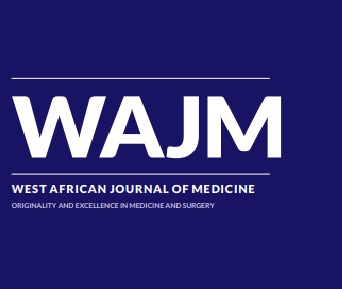ORIGINAL ARTICLES Determinants and Outcomes for Neonatal Septicaemia at the Federal Medical Centre Bida, North Central Nigeria
West Afr J Med . 2023 Aug 28;40(8):792-798.
Keywords:
Neonates; Risk factors; Septicaemia.Abstract
Abstract in English, FrenchBackground: Neonatal septicaemia (NNS) occurs during the first 28 days of life and is characterized by systemic bacterial infection proven by blood culture. It is a leading cause of morbidity and mortality in neonates. Determinants of NNS vary between locations forming the basis for this study.
Objective: To determine the prevalence and the predisposing factors to neonatal septicaemia among neonates admitted to the neonatal intensive care unit (NICU) of Federal Medical Centre, Bida (FMC Bida).
Methods: This was a one-year prospective observational study, 167 neonates admitted to the neonatal intensive care unit (NICU) of FMC Bida, were selected by purposive sampling method to participate in the study from 13th May, 2015 to 30th April, 2016. A structured questionnaire was filled out by consenting parents and blood samples were collected for laboratory analysis. The data was analyzed using SPSS version 20 (2016). The data were summarized using frequency distributions, means, standard deviation, charts and tables while statistical significance was determined using the chisquare test and Fisher's exact test at a 5% level of significance as well as Odd's Ratio (OR) as appropriate.
Results: Of the 167 neonates recruited, 97(58.1%) were males, 70(41.9%) were females and a male: female ratio of 1.4:1. Outborns were 100 (60%), inborns were 67(40%). Mean age was 4.3 ± 1.5 days and the mean weight of 2589 ± 743.9g. The overall prevalence of neonatal sepsis was 2.33% while the blood culture's positive rate was 9.58%. Risk factors identified in the neonates in this study were prolonged rupture of membranes (PROM), chorioamnionitis, meconium-stained liquor, foul-smelling vaginal discharge, being an outborn, having a low birth weight, inability to cry at birth and prematurity but, PROM was the only risk factor significantly associated with septicaemia (OR 5.4; 95% CI 2.2-13.5) while Escherichia coli was the leading bacterial isolate.
Conclusion: In conclusion, prolonged rupture of membrane was mostly responsible for neonatal septicaemia in this study.
Keywords: Neonates; Risk factors; Septicaemia.
G Ahmed 1, G O Oladele 2, A Usman 1, O Adesiyun 3, A O Olowu 4


